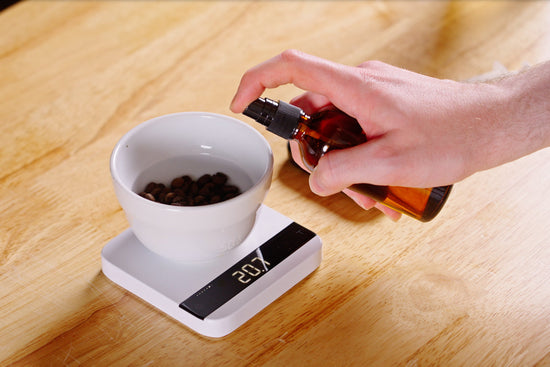MAXIMUM RDT: Is More Water Better?

Spraying water on your coffee beans before grinding them might sound a little out there at first, like some bizarre barista ritual meant only for the ultra-nerdy among us. But if you've spent two seconds online, you've probably heard of the Ross Droplet Technique (RDT). A quick spritz of water can reduce static during grinding, helping to prevent clumping and, ultimately, reduce channeling in your puck. In short: better consistency and better extractions.
We've been fans of RDT for several years now and were inspired when a scientific paper by Dr. Coffee himself, Chris Hendon, and a video by James Hoffmann suggested that more water might yield even higher extractions; thus, we got curious. We tried it, and it worked—a few extra sprays helped us pull sweeter, more even shots.
Naturally, the next question was: How much RDT is too much RDT?
The Experiment

We started with a simple setup: the Eureka Mignon Oro Single Dose grinder paired with the compact champion, the Profitec MOVE, grinding for a standard 1:2 ratio in about 30 seconds. The baseline was two sprays of water on the beans, which is about what we recommend for a home barista who pulls several shots per day.
From there, we added two more sprays per round: four sprays, six sprays, eight, ten, and so on. We measured extraction yields with a refractometer and tasted each shot, documenting the changes as we went. Our monomanical goal is to push RDT past the point of reason and see where the method breaks down, either in flavor, practicality, or mechanical failure.
The Limits of Reason

We'll spare you the play-by-play on every single shot (you can watch the video linked above for that), but here's what we observed:
-
4 sprays: Increased extraction, slightly more clarity in the cup. There is not a dramatic difference, but it is definitely a step up from the baseline.
-
6 sprays: We started noticing increased retention in the chute, with more grounds sticking to the grinder's internals. Still tasty, but a little messier.
-
8 sprays: At this point, we crossed a line. The grounds began clumping together in ways that were harder to break apart. Channeling increased. Flavor dropped.

-
10+ sprays: Don't try this at home. Things begin to get very weird. The grinder became bogged down with moisture-heavy grounds, requiring more cleaning between doses. Shots had extreme channeling, and the taste quality dropped sharply. Not to mention, it's just not fun having to clean and unjam your grinder constantly.
Eventually, we hit the upper limit, not because of some catastrophic grinder failure (thankfully), but because it just wasn't producing good espresso anymore.
How Much Is Too Much?

The short answer is between 4 and 6 sprays, depending on your grinder and dose size. Anything more risks retention, inconsistency, and potentially damaging your equipment. Please do not wash your burrs with water.
For daily use, 1–2 light sprays remain the sweet spot. You'll tame static electricity and improve your workflow without any of the downsides. If you're curious and want to push toward four sprays to see if they bump extraction, we're all for experimenting, but keep close attention on how your grinder behaves.
Final Thoughts
There's something inherently attractive about testing the limits of things, but consistency matters more than chasing marginal gains when it comes to making espresso every day. While this high-RDT experiment was fascinating, it's also a great reminder that more isn't always better. Listen, we tried to sound level headed and practical here, but in reality, we're always going to take it to the max and see what happens. Possible carnage? So be it.